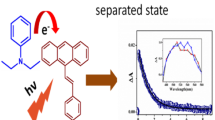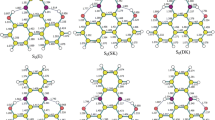Abstract
The photochemistry of three 9-(dihydroxyphenyl)anthracenes 6–8 was studied in neat CH3CN and selected organic solvents, to investigate excited state intramolecular proton transfer (ESIPT) from the phenol to the anthracene moiety. In D2O-CH3CN mixtures, the observed deuterium exchange of 6-8 is consistent with water-mediated (formal) ESIPT process from the ortho phenolic OH to the 10’-position of the anthracene ring, giving rise to quinone methide (QM) intermediates 12-14. There is no ESIPT for the corresponding methoxy-substituted compounds. Introduction of an extra hydroxyl group onto the phenol ring at different positions led to a range of deuterium exchange quantum yields (Φ = 0.03 to 0.15). In addition to the anticipated ESIPT process to the 10’-position, in neat CH3CN and other organic solvents, 6 (but not 7 or 8) undergoes a clean photocyclization to give bridged product 19 in quantitative yield. The mechanism of this unique photocyclization may involve a direct ESIPT or a 1,4-hydrogen transfer from the ortho phenolic OH to the 9’-position of the anthracene ring, generating a zwitterion (20) or diradical (21) intermediate, respectively, followed by ring closure. Fluorescence studies of 6 in various solvents show the existence of both local excited and intramolecular charge transfer states whereas only the former was present for 7 and 8, offering a possible rationalization for the photocyclization pathway.
Similar content being viewed by others
References
J. F. Ireland and P. A. H. Wyatt, Acid-base properties of electronically excited states of organic molecules, Adv. Phys. Org. Chem., 1976, 12, 131–221
W. Klöpffer, Adv. Photochem., 1977, 10 311
L. G. Arnaut and S. J. Formosinho, Excited-state proton transfer reactions I. Fundamentals, and intermolecular reactions, J. Photochem. Photobiol., A, 1993, 75, 1–20
S. J. Formosinho and L. G. Arnaut, Excited-state proton transfer reactions II. Intramolecular, reactions, J. Photochem. Photobiol., A, 1993, 75, 21–48
S. M. Ormson and R. G. Brown, Excited state intramolecular proton transfer part 1: ESIPT to nitrogen, Prog. React. Kinet., 1994, 19, 45–91
D. Le Gourriérec, S. M. Ormson and R. G. Brown, Excited state intramolecular proton transfer part 2: ESIPT to oxygen, Prog. React. Kinet., 1994, 19, 211–275
N. Agmon, Elementary steps in excited state proton transfer, J. Phys. Chem. A, 2005, 109, 13–35
J. T. Hynes, J. P. Klinman, H.-H. Limbach and R. L. Schowen, Editors, Hydrogen-transfer Reactions, Wiley-VCH, Weinheim, 2007.
A. Weller, Innermolekularer protonenübergang im angeregten zustand, Z. Ekectrochem., 1956, 60, 1144–1147.
M. J. Paterson, M. A. Robb, L. Blancafort and A. D. DeBellis, Mechanism of an exceptional class of photostabilizers: A seam of conical intersection parallel to excited state intramolecular proton transfer (ESIPT) in o-Hydroxyphenyl-(1,3,5)-triazine, J. Phys. Chem. A, 2005, 109, 7527–7537
T. P. Smith, K. A. Zaklika, K. Thakur, G. C. Walker, K. Tominaga and P. F. Barbara, Ultrafast studies on proton transfer in photostabilizers, J. Photochem. Photobiol., A, 1992, 65, 165–75.
D. Y. Han, J. M. Kim, J. Kim, H. S. Jung, Y. H. Lee, J. F. Zhang and J. S. Kim, ESIPT-based anthraquinonylcalix[4]crown chemosensor for In3+, Tetrahedron Lett., 2010, 51, 1947–1951
F. F. D. Oliveira, D. C. B. D. Santos, A. A. M. Lapis, J. R. Correa, A. F. Gomes Gozzo, C. Fabio, P. F. Moreira, V. C. de Oliveira, F. H. Quina and B. A. D. Neto, On the use of 2,1,3-benzothiadiazole derivatives as selective live cell fluorescence imaging probes, Bioorg. Med. Chem. Lett., 2010, 20, 6001–6007.
J. M. Kauffman, Review of progress on scintillator fluors for the detectors of the SSC, Radiat. Phys. Chem., 1993, 41, 365–371
A. Pla-Dalmau, 2-(2’-Hydroxyphenyl)benzothiazoles, benzoxazoles, and benzimidazoles for plastic scintillation applications, J. Org. Chem., 1995, 60, 5468–5473.
F. Vollmer and W. Rettig, Fluorescence loss mechanism due to largeamplitude motions in derivatives of 2,2’-bipyridyl exhibiting excitedstate intramolecular proton transfer and perspectives of luminescence solar soncentrators, J. Photochem. Photobiol., A, 1996, 95, 143–155
D.-Y. Chen, C.-L. Chen, Y.-M. Cheng, C.-H. Lai, J.-Y. Yu, B.-S. Chen, C.-C. Hsieh, H.-C. Chen, L.-Y. Chen, C.-Y. Wei, C.-C. Wu and P.-T. Chou, Design and synthesis of trithiophene-bound excited-state intramolecular proton transfer dye: enhancement on the performance of bulk heterojunction solar cells, ACS Appl. Mater. Interfaces, 2010, 2, 1621–1629.
K. Sakai, M. Takemura and Y. Kawabe, Lead chloride-based layered perovskite incorporated with an excited state intramolecular proton transfer dye, J. Lumin., 2010, 130, 2505–2507
M. Kasha, Protontransfer spectroscopy and proton-transfer lasers, Acta Phys. Pol., A, 1987, 71, 717–729
S. Park, O.-H. Kwon, S. Kim, S. Park, M.-G. Choi, M. Cha, S. Y. Park and D.-J. Jang, Imidazole-based excitedstate intramolecular proton-transfer materials: synthesis and amplified spontaneous emission from a large single crystal, J. Am. Chem. Soc., 2005, 127, 10070–10074.
B. Valeur, Molecular Fluorescence: Principles and Applications, Wiley-VCH Verlag GmbH, Weinheim, Chap. 4, 2001, pp. 99–106.
M. Kasha, Proton-transfer spectroscopy: Perturbation of the tautomeriztion potential, J. Chem. Soc., Faraday Trans. 2, 1986, 82, 2379–2392.
P. Wan, D. W. Brousmiche, C. Z. Chen, J. Cole, M. Lukeman and M. Xu, Quinone methide intermediates in organic photochemistry, Pure Appl. Chem., 2001, 73, 529–534
M. Lukeman and P. Wan, Excited state intramolecular proton transfer (ESIPT) in 2-phenylphenol: An example of proton transfer to a carbon of an aromatic ring, Chem. Commun., 2001, 1004–1005
M. Lukeman and P. Wan, A new type of excited-state intramolecular proton transfer: proton transfer from phenol OH to a carbon atom of an aromatic ring observed for 2-phenylphenol, J. Am. Chem. Soc., 2002, 124, 9458–9464
N. Basarić and P. Wan, Excited state proton transfer (ESPT) from phenol to nitrogen and carbon in (2-hydroxyphenyl)pyridines, Photochem. Photobiol. Sci., 2006, 5, 656–664.
M. Lukeman and P. Wan, Excited-state intramolecular proton transfer in o-hydroxybiaryls: A new route to dihydroaromatic compounds, J. Am. Chem. Soc., 2003, 125, 1164–1165.
M. Flegel, M. Lukeman and P. Wan, Photochemistry of 1,1’-bi-2-naphthol (BINOL)-ESIPT is responsible for photoracemization and photocyclization, Can. J. Chem., 2008, 86, 161–169.
M. Flegel, M. Lukeman, L. Huck and P. Wan, Photoaddition of water and alcohols to the anthracene moiety of 9-(2’-hydroxyphenyl) anthracene via formal excited state intramolecular proton transfer, J. Am. Chem. Soc., 2004, 126, 7890–7897
N. Basarić and P. Wan, Competing excited state intramolecular proton transfer pathways from phenol to anthracene moieties, J. Org. Chem., 2006, 71, 2677–2686
Y. Shi and P. Wan, Solvolysis and ring closure of quinone methides photogenerated from biaryl systems, Can. J. Chem., 2005, 83, 1306–1323.
M. D. Liptak, K. C. Gross, P. G. Seybold, S. Feldgus and G. C. Shields, Absolute pKa determinations for substituted phenols, J. A m. Chem. Soc., 2002, 124, 6421–6427
E. M. Crompton and F. D. Lewis, Positional effects of the hydroxy substituent on the photochemical and photophysical behavior of 3- and 4-hydroxystilbene, Photochem. Photobiol. Sci., 2004, 3, 660–668.
I. B. Berlman, Handbook of fluorescence spectra of aromatic molecules, Academic Press, New York, 1971, p. 363.
W. H. Melhuish, A standard fluorescence spectrum for calibrating spectro-fluorophotometer, J. Phys. Chem., 1960, 64 762.
M. Fischer and P. Wan, m-Quinone methides from m-hydroxy-1,1-diaryl alkenes via excited-state (formal) intramolecular proton transfer mediated by a water trimer, J. Am. Chem. Soc., 1998, 120, 2680–2681
M. Fischer and P. Wan, Nonlinear solvent water effects in the excited-state (formal) intramolecular proton transfer (ESIPT) in m-hydroxy-1,1-diaryl alkenes: efficient formation of m-Quinone Methides, J. Am. Chem. Soc., 1999, 121, 4555–4562.
I. A. Z. Al-ansari, Intramolecular charge transfer states in a series of (2,5-dimethoxyphenyl)-arenes, J. Photochem. Photobiol., A, 1993, 72, 15–21
J. Yin, M. P. Rainka, X.-X Zhang and S. L. Buchwald, A highly active suzuki catalyst for the synthesis of sterically hindered biaryls: novel ligand coordination, J. Am. Chem. Soc., 2002, 124, 1162–1163.
J. V. Lockard, A. B. Ricks, D. T. Co and M. R. Wasielewski, Interrogating the intramolecular charge-transfer state of a julolidineanthracene donor-acceptor molecule with femtosecond stimulated raman spectroscopy, J. Phys. Chem. Lett., 2010, 1, 215–218
W. Rettig, Charge separation in excited states of decoupled systems-TICT compounds and inplications refarding the development of new laser dyes and the primary process of vision and photosynthesis, Angew. Chem., Int. Ed. Engl., 1986, 25, 971–988
Z. R. Grabowski, K. Rotkiewicz and W. Rettig, Structural changes accompanying intramolecular electron transfer: focus on twisted intramolecular chargetransfer states and structures, Chem. Rev., 2003, 103, 3899–4032.
J. Herbich and A. Kapturkiewicz, Electronic and molecular structure of charge transfer singlet states: 4-(9-anthryl)julolidine and 4-(9-acridyl)julolidine, Chem. Phys. Lett., 1997, 273, 8–17
J. Herbich and A. Kapturkiewicz, Electronic structure and molecular conformation in the excited charge transfer singlet-states of 9-acridyl and other aryl derivatives of aromatic amines, J. Am. Chem. Soc., 1998, 120, 1014–1029
S. Lee, K. Arita, O. Kajimoto and K. Tamao, 4-(9-anthryl) aniline. 1, Intramolecular charge-transfer state formation in solution, J. Phys. Chem. A, 1997, 101, 5228–5231.
R. Nandy and S. Sankararaman, Donor-acceptor substituted phenyl-ethynyltriphenylenes-excited state intramolecular charge transfer, solvatochromic absorption and fluorescence emission, Beilstein J. Org. Chem., 2010, 6, 992–1001
S. Hagopian and L. Singer, Photophysical studies on 1-(p-aminophenyl)pyrene. Characterization of an intramolecular charge-transfer state with application to protontransfer dynamcs, J. Am. Chem. Soc., 1985, 107, 1874–1880.
Author information
Authors and Affiliations
Corresponding author
Additional information
Electronic supplementary information (ESI) available: Experimental details for the syntheses of compounds 9–11; 1H, 13C, 2D COSY, NOESY, HMQC and HMBC NMR spectra of isolated compounds; fluorescence spectra of 6–8 and 10 in various solvents; fluorescence decay profiles. See
Rights and permissions
About this article
Cite this article
Wang, YH., Wan, P. Excited state intramolecular proton transfer (ESIPT) in dihydroxyphenyl anthracenes. Photochem Photobiol Sci 10, 1934–1944 (2011). https://doi.org/10.1039/c1pp05187c
Received:
Accepted:
Published:
Issue Date:
DOI: https://doi.org/10.1039/c1pp05187c




